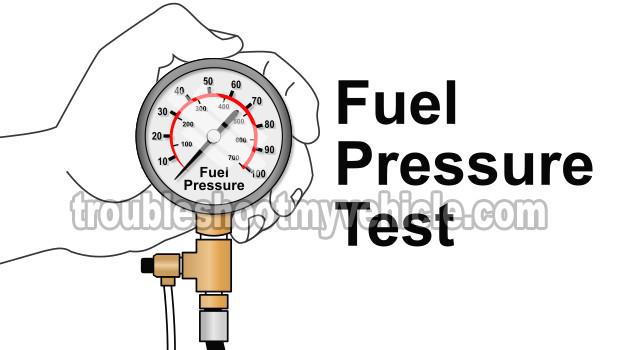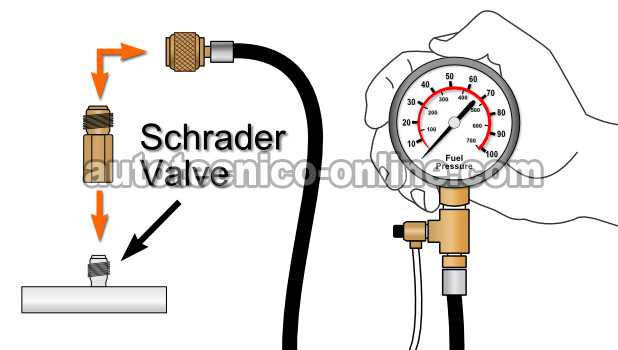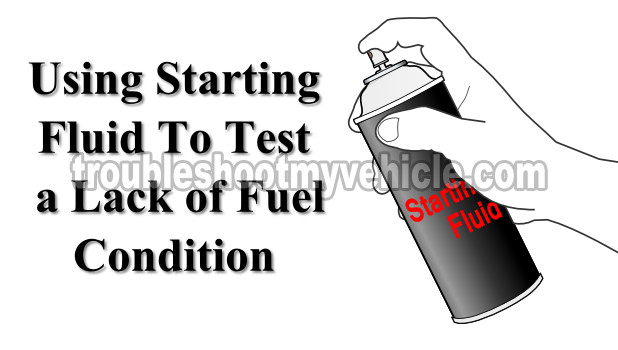
You can easily verify if the no-start condition on your Ford F150 (or Expedition, or Crown Victoria, or any 4.6L or 5.4L equipped car, pickup, or SUV) is due to a lack of fuel. In this ‘How To’ test article, I'm gonna' show you how to do it using one of two different diagnostic techniques.
One troubleshooting technique involves using starting fluid and the other involves using a fuel pressure gauge. Both methods will effectively let you know if the fuel pump is pumping fuel or not but only one is 100% accurate.
Contents of this tutorial:
A word of caution: starting fluid and gasoline are extremely flammable, so you need to be very careful around them. The tests I'm presenting to you here can be easily and safely done (and I've done them lot's of times without any unwanted and unhappy accidents), if you take all necessary safety precautions, stay alert and use common sense.
ES ![]() You can find this tutorial in Spanish here: Cómo Probar La Bomba de Combustible (Ford 4.6L, 5.4L) (at: autotecnico-online.com).
You can find this tutorial in Spanish here: Cómo Probar La Bomba de Combustible (Ford 4.6L, 5.4L) (at: autotecnico-online.com).
Symptoms Of A Bad Fuel Pump
When the fuel pump stops working, the most obvious symptom is that your 4.6L, 5.4L Ford (or Mercury or Lincoln) will ‘crank but not start’. Here are a couple of others that are more specific:
- You've got spark coming out of all of the Coil-On-Plug ignition coils or coil packs. So you know that the ignition system is not at fault.
- You've done a fuel injector Noid Light test, and all four fuel injectors are getting both 12 Volts and the activation signal.
- You've sprayed starting fluid into the throttle body and your vehicle started, even if only momentarily.
Although the above list is a not a very complete list of symptoms, the theme that runs thru' them, and any other related symptom, is that the engine will crank and crank, but not start.
NOTE: A fuel pump inertia switch that has triggered, will interrupt power going to the fuel pump. In layman's terms, this means the fuel pump will not run. So, it's always a good idea to check the fuel pump inertia switch first. For more info on this, see: Checking The Fuel Pump Inertia Switch.
Which And Where To Buy A Fuel Pressure Gauge
Owning a fuel pressure gauge is now becoming a must. All vehicles now use an electrical fuel pump to deliver fuel (under high pressure) to the fuel injectors and the best way to diagnose this fuel pump is with a fuel pressure gauge.
The following fuel pressure test gauge kits have the Schrader valve adapter you need to test the fuel pressure on your Ford:
Disclosure: As an Amazon Associate, I earn from qualifying purchases. If my tutorials help you, using these links is an easy way to support the site at no extra cost to you. Thank you!
FUEL PUMP TEST 1: Using A Fuel Pressure Gauge

Testing the fuel pump's pressure is one of the most accurate ways to verify that the fuel pump is good or bad.
Ford has made it super easy to attach a fuel pressure gauge to the fuel system to test the fuel pump since there's a Schrader valve on the fuel rail (see image 1 of 2 in the image viewer).
If you don't own a fuel pressure gauge, I have made some recommendations at the end of the article on which fuel pressure gauge set to buy and where to buy it.
NOTE: Before you begin, check the fuel pump inertia switch first: Checking The Fuel Pump Inertia Switch.
These are the test steps:
- 1
Connect the fuel pressure gauge to the Schrader valve on the fuel rail.
SCHRADER VALVE LOCATION: Location Of The Schrader Valve. - 2
When ready, ask your helper to crank the engine while you observe the fuel pressure tester's gauge.
- 3
Your fuel pressure gauge will register one of the two following results:
1.) The fuel pressure gauge will register 35 PSI, or
2.) The fuel pressure gauge will register 0 PSI.
OK, now that the testing part is done, let's take a look at what your results mean:
CASE 1: If the fuel pressure gauge registered 0 PSI. This confirms that the cause of your F150's (Expedition, Crown Victoria, Thunderbird, Cougar, Grand Marquis, etc.) is caused by a lack of fuel.
This result usually means that the fuel pump is bad but not always. For example, you could have a blown fuel pump fuse, or a bad fuel pump relay or a fuel pump interrupt switch that has activated.
Taking into account the above conditions I've just mentioned and to make sure that the fuel pump is really the cause of this 0 PSI fuel pressure reading, you must verify that the fuel pump is getting power (12 Volts) when the engine is cranking (this is accomplished from underneath the vehicle, by tapping into the wire that feeds the fuel pump with power, with a multimeter).
CASE 2: If the fuel pressure gauge registered 35 PSI: This fuel pressure gauge result lets you know that the fuel pump is working and delivering enough fuel to the fuel injectors.
The cause of your Crown Victoria's (E150, Mustang, Town Car, Navigator, Thunderbird, etc.) no-start condition is caused by something else.
FUEL PUMP TEST 2: Spraying Start Fluid Into The Throttle Body

I'm going to jump into the lack of fuel troubleshooting with the starting fluid test. This is probably the fastest and the one that does not require any expense to do (like buying a fuel pressure gauge). With this test, you'll be able to confirm if the no-start condition, on your Ford Expedition (Cougar, Thunderbird, Explorer, Mountaineer, etc.), is being caused by a lack of fuel (although it's not the most accurate way of diagnosing a bad fuel pump).
Before you jump into the actual test (on your F150, Mustang, Thunderbird, Navigator, Grand Marquis, etc.), you must first check that the ignition system is creating and delivering spark to all of the spark plugs. This is important cause if there's no spark, then none of the tests in this article will help you. Not only that, this no spark results tells you that the cause of the no-start is not due to a bad fuel pump.
NOTE: If you haven't already, check the to make sure the fuel pump inertia switch isn't behind the no-start problem. See: Checking The Fuel Pump Inertia Switch.
OK, enough talking -let's get this ball rolling:
- 1
Disconnect the air intake duct from the throttle body.
The end that connects to the air filter box (or canister) can remain connected to it. - 2
Manually open the throttle and spray starting fluid down the bore and then, quickly, reconnect the air duct to the throttle body (you don't have to tighten the hose clamp).
- 3
Have your helper crank the engine once the intake air duct is back on the throttle body.
NOTE: Having the intake air duct back on is a safety precaution, since the starting fluid could cause a back-fire to come out thru' the throttle body. - 4
One of two things is gonna happen:
1.) The engine will start, even if it's just momentarily or for a few seconds and then die or.
2.) The engine will only crank but not start at all.
Alright, let's interpret your results by choosing one of the following CASES:
CASE 1: If the engine started, even momentarily. This test result indicates that the no-start condition your Ford vehicle is experiencing is due to a lack of fuel.
This test result usually confirms that the fuel pump is bad (in about 80% of the cases) and replacing it will solve the no-start problem but not always.
In about 20% of the cases, this lack of fuel could be caused by a blown fuse, a bad fuel pump relay, a triggered fuel pump interrupt switch etc. So, keeping this in mind, I suggest you do two more things:
- Remove the fuel line that connects to the fuel injector rail (this is the one that delivers fuel from the fuel filter) and place it in a container. When ready, have your helper bump the starter motor while you verify if fuel comes out or not. No fuel coming out of the fuel line further confirms a bad fuel pump.
- Find the wire (circuit) that feeds power (12 Volts) to the fuel pump and with a multimeter in Volts DC mode, verify that 12 Volts are reaching the fuel pump when you crank the engine.
CASE 2: The engine did not start, not even momentarily. This indicates that the no-start condition is NOT due to a lack of fuel.
Now, since a starting fluid test is not the most accurate way to find out if the fuel pump is bad, I suggest you do one more test.
This is to use a fuel pressure gauge to see the exact amount of fuel pressure the fuel pump is producing. For more info on this test, go to: FUEL PUMP TEST 1: Using A Fuel Pressure Gauge.
Another handy tutorial is this one: How To Test A No Start Condition (Ford 4.6L, 5.4L).
Location Of The Schrader Valve

The Schrader valve is always located on the fuel injector rail (on the vehicles covered by this tutorial). Generally on the passenger side of the engine.
Checking The Fuel Pump Inertia Switch

The fuel pump inertia switch is tasked with the job of cutting power (or Ground) to the fuel pump in case of an impact, which causes the engine to stall (if it was running) or for the engine to crank but not start due to a lack of fuel.
Although it's designed to activate during a severe impact cause by an automobile accident, sometimes it gets activated by less than severe impacts (and this happens a lot).
This means that it's always a good idea to check and reset the inertia switch whenever testing the fuel pump. On the majority of the vehicles covered by this tutorial, the inertia switch is located below the right side of the instrument panel, behind the trim panel.
Resetting the fuel pump inertia switch simply involves pushing down on the button located on top of the inertia switch till it bottoms out. If the inertia switch has been jolted into shutting off the fuel pump, you'll feel a definite ‘click’ as you depress the button.
Related Test Articles
It's my mission to give you real world ‘how to test’ tutorials to help you to really test this or that on your 4.6L and 5.4L V8 Ford vehicle, so I've written several articles that may be of interest to you. You can find them here: Ford 4.6L, 5.4L Index Of Articles.
Here's a sample of the tutorials you'll find in the index:
- Troubleshooting P0172 And P0175 (Ford 4.6L, 5.4L).
- How To Test The Blower Motor (Ford 4.6L, 5.4L).
- How Can I Tell What's Wrong With My Transmission? (Ford 4.6L, 5.4L).
- How To Test Ford Coil-On-Plug Ignition Coils 4.6L and 5.4L V8 Engines (at: easyautodiagnostics.com).
- How To Test The Throttle Position Sensor Ford, Mercury, Lincoln 4.6L and 5.4L Engines (at: easyautodiagnostics.com).
- How To Test The FORD MAF 4.2L, 4.6L, 5.4L Round Air Filter Canister Assembly MAF Sensor (at: easyautodiagnostics.com).
- How To Test Ford MAF Sensors Using a Multimeter (at: easyautodiagnostics.com).

If this info saved the day, buy me a beer!




